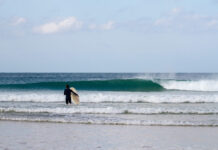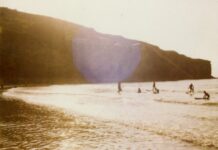Who Was Involved?
Born in 1957 in Newcastle, Australia, Mark Richards was something of a surfing prodigy. Influenced by his father’s relationship with the culture both in (as a surfer) and out (as the first surf shop owner in Newcastle) of the water, Richards began stand-up surfing at the age of six years old, placing runner-up at the Australian National Titles junior division and joining the national team for the World Surfing Championships when only fifteen years old. At eighteen, he won two pro contests in Hawaii, carving his name in the international surf scene; then at age 22, packing his own redesign of the twin-fin surfboard and a polished, powerful, turn-focussed style, Richards won his first world title, repeating the feat for the following three seasons.
Richards’ shaping experience began when he was gifted a planner at thirteen years old, but it wasn’t until heading to Hawaii in the winter of 1966-67 to work under Dick Brewer that his relationship with surfboard design stepped up a level. Having honed his technique, Richards set off to create some of the ideas that had been simmering in his head, most of which revolved around improving his performance on the small-wave events in the World Tour. This led him to rework the twin-fin design to fit his tall and slim build, style, and ambitions.
Design Details
Even before MR’s development of the twin-fin model, a double-fin configuration had always been synonymous with speed, due to the way water channels between the two fins. In that sense, what made Richards’ design unique wasn’t the fact that it had two fins, but the way in which he combined other design elements – chiefly the shape of the tail and the position and outline of the fins – to optimise the design’s potential, creating a more versatile craft altogether.
With a concave fluted wing near the tail and nose-to-tail hard rails, the MR Twin bit into the wave enough to give the board more drive and stability when arcing his way up and down the face; the combination of an increased width in front of the wings with reduced surface area behind them, provided enough grip to hold through turns without compromising speed or spinning out – which was something single-fins struggled with when under-pressure.
Richards was focussed on carving powerful arcs, and the way in which one fin works as a pivot point for the other in a twin setup allowed him to do just that, redirecting the board with ease. However, the bigger and more powerful the waves grew (6ft being a generous threshold), the more difficult it became to control this pivoting tendency, particularly in deep bottom turns.
With no trailing centre fin, previous twin fins had the two fins placed pointing forward, creating the opportunity to track down the line, with less drag and riding faster than a single-fin. But since Richards prioritised curves over lines, he angled both fins inward (toe-in) whilst also leaning them out (cant), thus reducing the board’s susceptibility to track.
Although a mere 6’2”, which was a short surfboard for someone with Richards’ build, the board’s outline also had a lot of surface area towards the nose so that paddle speed wasn’t sacrificed. More overall planning surface also meant more speed, and by making the board smaller than the standard of the time, Richards made it even more manoeuvrable.
Specifications
| Avg Minimum | Avg Maximum | ||
| Length | 6’2” | 6’6” | |
|
Width |
Nose | ||
| Midpoint | 20 1/4” | 20 3/4” | |
| Tail | |||
| Thickness | 2 3/4” | 2 3/4” | |
| Weight or Volume? | 38.75 L | 42.25 | |





